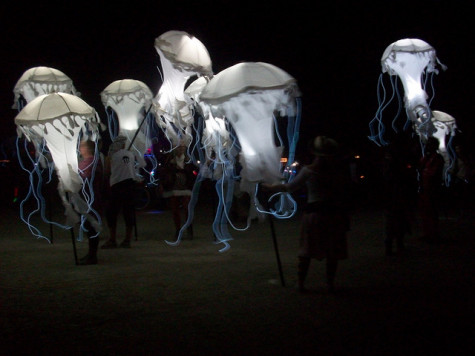 My kids are really into this cartoon called The Octonauts. It’s about a group of undersea rescuers and researchers (there’s a penguin medic, a sea otter marine biologist, a polar bear captain, among others, plus a group of squeaky-voiced creatures called vegimals.) In one of their (and my) favorite episodes, one of the crew members stays out all night to observe shy garden eels. Others wonder if he’ll be ok all alone out there, but the captain says it looks like it will be a quiet night: “Nothing out there but one little jellyfish. What could go wrong?”
My kids are really into this cartoon called The Octonauts. It’s about a group of undersea rescuers and researchers (there’s a penguin medic, a sea otter marine biologist, a polar bear captain, among others, plus a group of squeaky-voiced creatures called vegimals.) In one of their (and my) favorite episodes, one of the crew members stays out all night to observe shy garden eels. Others wonder if he’ll be ok all alone out there, but the captain says it looks like it will be a quiet night: “Nothing out there but one little jellyfish. What could go wrong?”
But of course, everything does. When the crew wakes the next morning, sea nettle jellyfish have descended like so many snowflakes, and hijinks (and of course, a rescue) ensue.
Less easily resolved are the jellyfish blooms that happen in the real ocean. They can be a problem for people and the things we’ve created. Some jellyfish sting, but blooms can cause more widespread trouble: they’ve caused shut-downs at power plants, wiped out salmon farms, and the 450-pound Nomura jellyfish have been wrecking fishermen’s nets and livelihoods in the Sea of Japan. (“I wouldn’t say the jellyfish are doing this intentionally,” one researcher told the Washington Post.)
These are problems we may have helped create. Jellyfish seems to favor the dead zones caused by pollution; polyps grow in the protected spots created by developed beachfronts. What seems like an increasing number of blooms has been fingered as an indication of an ailing ocean, but a 2013 study suggests that cyclical trends could also be driving what researchers called a small increase in jellyfish since 1970.
To learn more about jellyfish and what might be behind their blooms, scientists are doing everything from tracking jellyfish with specially-designed tags (they suction onto the jelly’s bell) to enlisting citizen scientists around the world to report jellyfish sightings. JellyWatch, launched in 2010, came out with an app last year that lets users send in photos and updates of blooms, red tides, mammals and more—in several languages. Researchers are using these reports alongside ocean wave and weather data to figure out jellyfish movement patterns.
I’ve downloaded the jellyfish app, but like so many citizen science projects that have caught my interest, I’m afraid that my enthusiasm will wane—not wane, exactly, but that I’ll get caught up in something else that will prevent me from paying attention. I do feel like I pay attention, but often not to the right things—to the elusive garden eels instead of the single jellyfish right in front of me, to the rare and unusual instead of the small things that might add up to something more. It looks like a quiet world out there most days. What could go wrong?
**
Image of the dancing, glowing puppets of Billion Jelly Bloom by Alisha Vargas via Flickr/Creative Commons
Jellyfish loves pollution. They are a type of zooplankton and so they are different from fishes that dominate the oceans. Fishes and most other animals are declining due to pollution, global warming, over-fishing etc. As a result, jellyfishes face lesser competition in getting food. More food equals to more increase of population. In this way, the empire of the jelly blooms are spreading.